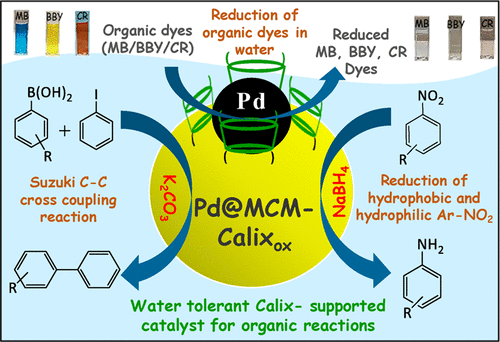Our official English website, www.x-mol.net, welcomes your
feedback! (Note: you will need to create a separate account there.)
Calixarene-Assisted Pd Nanoparticles in Organic Transformations: Synthesis, Characterization, and Catalytic Applications in Water for C–C Coupling and for the Reduction of Nitroaromatics and Organic Dyes
ACS Omega ( IF 3.7 ) Pub Date : 2019-03-05 00:00:00 , DOI: 10.1021/acsomega.9b00095 Nilesh Narkhede 1 , Bhawna Uttam 1 , Chebrolu Pulla Rao 1
ACS Omega ( IF 3.7 ) Pub Date : 2019-03-05 00:00:00 , DOI: 10.1021/acsomega.9b00095 Nilesh Narkhede 1 , Bhawna Uttam 1 , Chebrolu Pulla Rao 1
Affiliation

|
A new type of ternary hybrid, [email protected]ox, based on mesoporous silica, calixarene conjugate, and Pd(0) nanoparticles (NPs) was synthesized by sacrificial oxidation of allylic calixarene conjugate eventually functionalized with mesoporous silica without using any external reducing agent. The role of the calix conjugate in the formation of [email protected]ox has been established. The hybrid, [email protected]ox, was characterized by different techniques to support the formation of well-dispersed Pd(0) NPs of 12 ± 2 nm size. The catalyst, [email protected]ox, has been proven to be a resourceful one in water in three different types of reactions, namely, Suzuki C–C cross coupling, reduction of both hydrophilic and hydrophobic nitroaromatic compounds, and reduction and degradation of cationic, anionic, and neutral organic dyes. The catalyst exhibited higher turnover frequencies for all these transformations even when a very low concentration of Pd-based catalyst was used. The [email protected]ox hybrid catalyst can be recycled several times without experiencing any significant loss in the activity. Also, the regenerated catalyst showed retention of well-spread Pd(0) species even after several catalytic cycles. The tetraallyl calixarene, allylCalix, conjugate acts as a reducing agent, also controls the size, and yields the well-dispersed Pd(0) NPs. The calix conjugate further provides a hydrophobic core in assisting the diffusion of hydrophobic substrates toward catalytic sites.
中文翻译:

杯芳烃辅助的钯纳米颗粒在有机转化中的应用:水中的C–C偶联和还原硝基芳烃和有机染料的合成,表征和催化应用
通过牺牲氧化最终被介孔二氧化硅官能化的烯丙基杯芳烃共轭物,而无需使用任何外部还原剂,合成了一种基于介孔二氧化硅,杯芳烃共轭物和Pd(0)纳米粒子(NPs)的新型三元杂化[电子邮件保护] ox。 。已经确定了杯状共轭物在[受电子邮件保护的] ox的形成中的作用。杂种[受电子邮件保护的] ox通过不同的技术来表征,以支持12±2 nm大小的分散良好的Pd(0)NP的形成。催化剂,[受电子邮件保护]牛事实证明,在三种不同类型的反应中,三价铬是水中的一种重要物质,即铃木C–C交叉偶联,亲水性和疏水性硝基芳族化合物的还原以及阳离子,阴离子和中性有机染料的还原和降解。即使使用非常低浓度的Pd基催化剂,该催化剂对于所有这些转化也显示出较高的周转频率。[受电子邮件保护的]牛杂化催化剂可以循环使用几次,而活性没有任何重大损失。此外,再生的催化剂即使在几个催化循环后仍显示出良好扩散的Pd(0)种类的保留。四烯丙基杯芳烃,烯丙基Calix,共轭物充当还原剂,还控制尺寸,并产生分散良好的Pd(0)NP。杯状共轭物还提供疏水核,以帮助疏水底物向催化位点扩散。
更新日期:2019-03-05
中文翻译:

杯芳烃辅助的钯纳米颗粒在有机转化中的应用:水中的C–C偶联和还原硝基芳烃和有机染料的合成,表征和催化应用
通过牺牲氧化最终被介孔二氧化硅官能化的烯丙基杯芳烃共轭物,而无需使用任何外部还原剂,合成了一种基于介孔二氧化硅,杯芳烃共轭物和Pd(0)纳米粒子(NPs)的新型三元杂化[电子邮件保护] ox。 。已经确定了杯状共轭物在[受电子邮件保护的] ox的形成中的作用。杂种[受电子邮件保护的] ox通过不同的技术来表征,以支持12±2 nm大小的分散良好的Pd(0)NP的形成。催化剂,[受电子邮件保护]牛事实证明,在三种不同类型的反应中,三价铬是水中的一种重要物质,即铃木C–C交叉偶联,亲水性和疏水性硝基芳族化合物的还原以及阳离子,阴离子和中性有机染料的还原和降解。即使使用非常低浓度的Pd基催化剂,该催化剂对于所有这些转化也显示出较高的周转频率。[受电子邮件保护的]牛杂化催化剂可以循环使用几次,而活性没有任何重大损失。此外,再生的催化剂即使在几个催化循环后仍显示出良好扩散的Pd(0)种类的保留。四烯丙基杯芳烃,烯丙基Calix,共轭物充当还原剂,还控制尺寸,并产生分散良好的Pd(0)NP。杯状共轭物还提供疏水核,以帮助疏水底物向催化位点扩散。













































 京公网安备 11010802027423号
京公网安备 11010802027423号